Kyneton, which is named after the English village of Kineton in Warwickshire, England, is located halfway between Melbourne and Bendigo, in the Macedon Ranges region of Victoria, Australia.
Kyneton is a short drive to Hanging Rock, Macedon Regional Park.
The Indigenous People
Aboriginal people have lived in Australia for at least 40,000 years.
The Campaspe River at Kyneton is the traditional border
between the lands of the Dja Dja Wurrung (Yes Yes tongue/speak), and Taungurung people of the Kulin Nation.
The various clans of the Kulin people spoke different dialects, but they were linked by common elements in language, beliefs and practices.
As with other Kulin peoples, Bunjil the Wedge-tailed Eagle and Waa the Crow are the moieties of the
traditional patrilineal kinship system (they traced their descent from the father).
In the dreaming stories of Djandak (Country), Bunjil is the creator-being and hero. The land and people
were created by Bunjil, often depicted as a wedge-tailed eagle (or eaglehawk).
Bundjil possessed two wives, a son -Binbeal the rainbow, and a brother Pailian the bat. The Earth and the mountains, rivers, flora, fauna, and human laws, many Aboriginal people believed, were made by Bundjil.
Men and women from the Bunjil moiety had to marry partners from the Waa moiety. Men sought wives from another clan. If they were Waa they had to marry Bunjil. Often marriages were arranged by infant betrothal, occurring between a young girl and an older man. The female would move to live with her husband's clan.
Native Tribes of South-East Australia.
The only known rock art depiction of Bunjil in Victoria is located at the Black Range Scenic Reserve near Stawell (2 hr 16 min (201.5 km) via C221). There are a range of significant Indigenous sites in the Macedon Ranges, such as e
vidence of scarred trees, rock scatters, quarries, grinding-stones, ceremonial grounds and ochre pits.
Edward Dryden, one of
the first settlers in the Mt Macedon region in 1839 wrote some years later: "Of the aborigines of my time the was a tribe of about 150...who camped from place to place..." It is believed that corroborees were held where Market St is now located."
 |
| Robbing a bee tree, 1887, State Library of Victoria |
 |
| Aboriginal family, New Holland (Australia), c1839, British Library digitised image from page 982 of "De Aardbol. Magazijn van hedendaagsche land- en volkenkunde ... Met platen en kaarten [Deel 4-9 by P. H. W.]" |
 |
| Copy of an emu feather skirt made by Dja Dja Wurrung artist at Australian Museum. Worn by Aboriginal women during ceremonies |
Major Sir Thomas Mitchell
Major Sir Thomas Mitchell and members of his 1836 expedition were the first Europeans to pass through Kyneton.
On this journey, Mitchell named the Campaspe River after a mistress of Alexander the Great, whose portrait he had seen previously, as the beauty of the river reminded him of her.
 |
| Portrait of Major Sir Thomas Livingstone Mitchell (c. 1830s), SLNSW |
Overlanders
Sheep and cattle farmers, commonly called "Overlanders", soon followed in Mitchell's footsteps and they began settling the fresh grazing lands of southeastern Australia.
Charles Ebden, one of the first settlers to the region, established Carlsruhe Station in May 1837. This was the first pastoral settlement north of the Great Divide in Victoria.
Carlsruhe Station
Whilst on the road to Kyneton, Charles Ebden was observed near Goulburn, "in a most strange costume, with a fur skin jacket and
cap, his beard long … very different from the Mr E. in his tandem in
George-street, Sydney … He has
at present on the road about nine
thousand sheep, thirty horses, and nine drays".
 |
| Age (Melbourne, Vic. : 1854 - 1954), Saturday 28 November 1936 |
Skelsmergh Hall
William Degraves acquired Carlsruhe Station in the 1850s. He was the son of Peter Degraves, who established the Cascade Brewery in Van Diemen's Land. Degraves built Skelsmergh Hall in 1859, which was originally known as Montpellier, after the town in Southern France where Degraves Huguenot ancestors originated.
 |
| Skelsmergh Hall, built in 1859 for William Degraves. A two-storey, ten-roomed bluestone dwelling and was constructed of Malmsbury stone |
The Jefferys Family
In 1841, Edward Jeffreys bought Five Mile Creek Station, located close to today's town of Woodend. Soon afterwards, Edward was joined by his brothers, Frederick and Henry Charles, but they found the slab hut they had built was filled with travellers, so they moved their station a few kilometres further down in March 1841.
A corn mill was in operation by 1841.
Another brother, Herbert Castelman Jeffreys arrived to join the brothers in 1842. The brothers renamed this station "Kyneton", after the village of Kineton (pron. Kyneton), located in Warwickshire England.
In 1843, Julia Jeffreys came out from England to live with her sons at Kyneton. The brothers “built a pretty verandahed cottage at that time
a superior residence for the bush, which took us all in. We had hitherto lived in an ordinary slab hut”.
Superintendent LaTrobe of the Port Phillip District visited Jeffreys' Station and gave Mrs Jeffreys the privilege of
naming the town. She suggested the name Kyneton meaning, "the town at the back of the wood".
In the early days, a police camp existed at the junction of Post Office Creek with the Campaspe river.
 |
| Degraves Mill, a large 1850s steam flour mill, is located on the Campaspe River on the site of the head station of the Carlsruhe Run, established by Charles Ebden in May 1837. |
A Town Develops
Before the town was surveyed in 1849, Kyneton was known as Campaspe Flat, boasting only a collection of slab huts and tents. However, with the decision that Kyneton was to become a legal and
administration centre, the town began to develop.
Kyneton was gazetted in 1850.
Gold was found at Bendigo and Mt Alexander in late 1851 and Kyneton
developed as a service centre on the way to the goldfields. The gold escort stable was on the comer of Ebden and Simpson Streets.
Many people
arrived from overseas to try their luck at finding gold and the road to the goldfields was "one continuous line of diggers‟.
A Major Coach Stop
During the gold rush of the 1850s, Kyneton became a major coach stop and gateway to the goldfields. Money flowed into Kyneton, and substantial bluestone, brick and weatherboard houses; shops, hotels and administrative buildings began to be built. And amazingly, John Apperley's
hotel the Great Western, supposedly, had an enormous stable alongside it, claiming that it had
"Stabling for 1000 Horses".
By the 1850s, various bluestone buildings had been built at Kyneton including: the Kyneton Courthouse (1856), the Anglian church (built 1852 and rebuilt 1856), the Congregational Church (built 1853 and rebuilt 1860) and the Mechanics Institute (1854, rebuilt 1897).
Cobb and Co. ran a coach service, the "Leviathan", with 22 horses and 75 passengers, from Kyneton to Castlemaine. Melbourne’s Argus newspaper reported that the coachbuilder, J.D. Morgan, built the "Leviathan" in his Ballarat workshops at a cost of £375. The coach had five rows of seats inside and seven "outside" on the roof.
In 1852 Kyneton had four hotels but no
churches or banks. One of these hotels, "Tolmies Inn" (Robert Burns Hotel), located on the corner of Wedge and Yaldwin Streets, cost about £14,000 to build. Dr Kelly who was an early medical doctor at Kyneton, also lived at the Robert Burns Hotel, at one time. Sometimes, on the way back to his room, Dr Kelly would have to step over the bodies of diggers returned from the goldfields, as every single stair was occupied and its occupants charged "as a bed".
Lord Robert Cecil, who visited the Kyneton diggings in 1852, recalled how the diggers at Specimen Gully “showed me what the natives call “blackfellows sugar.” It is a species of manna falling plentifully from the white gum.
It tastes very much like the second layer in a wedding cake”.
On 30 January 1854, the Cobb & Co. coach began its service to Castlemaine and Bendigo. The coach left the Criterion Hotel, Collins Street
every morning (Sundays excepted) at 6:00 am. It stopped at Essendon, Keilor, Gap, Gisborne, Woodend, Carlshrue, Kyneton, Malmsbury and Elphinstone.
The Kyneton Agricultural Society was formed on October 29th 1856.
The Argyle steam flour mill was built, near the Campaspe River, in 1857. and the Degraves mill, to the west of Kyneton, in the same year.
 |
| Kyneton Approaching Kyneton from Castlemaine, circa 1861. STATE LIBRARY VICTORIA |
Caroline Chisholm
 |
| Caroline Chisholm, Catholic Press (Sydney, NSW : 1895 - 1942), Thursday 8 December 1910 |
Caroline Chisholm lived at Kyneton in 1858. Archibald, her husband, served as a magistrate, and the two elder sons helped to run the store that the Chisholm's had purchased. Caroline Chisholm began to
establish shelter sheds for families to stay when heading for the goldfields.
 |
| Kyneton Observer (Vic. : 1856 - 1900), Friday 18 December 1857 |
The Gold Diggers' Arms Hotel
The Gold Diggers' Arms Hotel and was established around 1852, by African-American publican, John Byng. Described as a “thick set, black man”, Byng came from Digby, Nova Scotia in Canada, where his father – a freed slave –
settled after the American Revolution. This hotel is now called The Royal George Hotel.
The Albion Hotel, formerly the Club Hotel, was built in 1861.
Kelly and King
Kyneton's courthouse and lock-up once held Ned Kelly. Kelly was released on June 3rd 1870. He then stayed at the New Market Hotel
in the town before returning home. Another notable person who stayed
at a hotel in Kyneton was John King, the lone survivor of the ill-fated Burke and Wills expedition in 1860.
Burke and Wills passed through the Macedon Ranges in 1860, on their way to the Gulf of Carpentaria. Today, you can still trace their path on the Burke and Wills Track outside Lancefield.
The Newmarket Kyneton Hotel — or “The Newie”— was built in 1860.
 |
| Newmarket Hotel, Kyneton, VIC, Weekly Times (Melbourne, Vic. : 1869 - 1954), Saturday 1 December 1900 |
 |
Piper Street, Kyneton Victoria circa 1861
|
A flour mill was constructed on the corner of Ebden and Piper Streets in 1862.
The rail line from Melbourne arrived in 1862.
The Bank of New South Wales at Kyneton was built in l865.
 |
| Kyneton District, Victoria, circa 1865. Museum Victoria. Public Domain |
The Kyneton Fire Brigade was establsihed in 1866.
Reminiscences of Old Kyneton
Henry James Goldsmith Armstrong (1846 – 1916) was a solicitor at Kyneton. He was admitted to practice as an Attorney, Solicitor and Proctor of the Supreme Court of Victoria in 1869. He wrote "Some reminiscences of old Kyneton" in 1877. Armstong commenced a practice in Kyneton and he remained there for the rest of his life. The firm he founded still exists – Armstrong, Collins & DeLacy. (
read here)
As the gold rush began to subside, farming gained in importance at Kyneton and a more sedate atmosphere began to develop in the town.
1870s
 |
| Pupils & Teacher, Kyneton District, Victoria, circa 1870, Museums VIC |
 |
| Age (Melbourne, Vic. : 1854 - 1954), Saturday 21 May 1870 |
1890s
A meeting that was held in the Kyneton Mechanics Institute in 1893 led to the Corowa Conference that eventually led to the Federation of Australia.
The Kyneton Mineral Springs Reserve is located close to the Campaspe River, locally known as Boggy Creek. The springs were found in 1890.
1900
 |
| Goldsmith's Livery, Kyneton, VIC, Weekly Times (Melbourne, Vic. : 1869 - 1954), Saturday 1 December 1900 |
 |
| Barry's Court House Hotel, Kyneton, VIC, Weekly Times (Melbourne, Vic. : 1869 - 1954), Saturday 1 December 1900 |
 |
| Kyneton Butter Factory, VIC, Weekly Times (Melbourne, Vic. : 1869 - 1954), Saturday 1 December 1900 |
 |
| Kyneton News Agency, VIC, Weekly Times (Melbourne, Vic. : 1869 - 1954), Saturday 1 December 1900 |
 |
| Rawson's Importer, Kyneton, VIC, Weekly Times (Melbourne, Vic. : 1869 - 1954), Saturday 1 December 1900 |
 |
| Wedgewood's Hotel, Kyneton, VIC, Weekly Times (Melbourne, Vic. : 1869 - 1954), Saturday 1 December 1900 |
 |
| Kyneton Show, VIC, Weekly Times (Melbourne, Vic. : 1869 - 1954), Saturday 29 November 1902 |
 |
| Afternoon tea, Kyneton Show, VIC, Australasian (Melbourne, Vic. : 1864 - 1946), Saturday 28 November 1908 |
 |
| Masonic Ball, Kyneton, VIC, Punch (Melbourne, Vic. : 1900 - 1918; 1925), Thursday 8 September 1910 |
 |
Kyneton fire brigade, Victoria - circa 1910, Kaye
|
 |
| Many Aboriginal people lived on camps on the outskirts of town. Aboriginal people west of Darling River, Leader (Melbourne, Vic. : 1862 - 1918, 1935), Saturday 4 June 1910 |
 |
| Mollison St Kyneton, VIC, Weekly Times (Melbourne, Vic. : 1869 - 1954), Saturday 29 November 1913 |
 |
| At Kyneton Show, VIC, Weekly Times (Melbourne, Vic. : 1869 - 1954), Saturday 29 November 1913 |
 |
Mollison St. Kyneton (1914-1916) .This work is out of copyright
|
WWI
 |
Mrs Fraser, of Kyneton, has received the following cablegram from her son, Lieut. A. J. Fraser,; of -the Machine Gun Battalion,.- A.I.F., from the 3rd Stationary Hospital, London: — 'Three bullets in right shoulder; bones unin jured. Military Cross.Winner (Melbourne, Vic. : 1914 - 1917), Wednesday 22 August 1917 |
 |
| James Gardiner Daniel, Service Number: 300, Rank: Sergeant, Unit: 7th Australian Infantry Battalion, Service: Australian Army, Conflict: First World War, 1914-1918, Date of death: 28 February 1917, Place of death: France, Cause of death: Died of wounds, Age at death: 27, Place of association: Kyneton, Australia Cemetery or memorial details: Dernancourt Communal Cemetery Extension, Dernancourt, Picardie, France Source: AWM145 Roll of Honour cards, 1914-1918 War, Army Kaye |
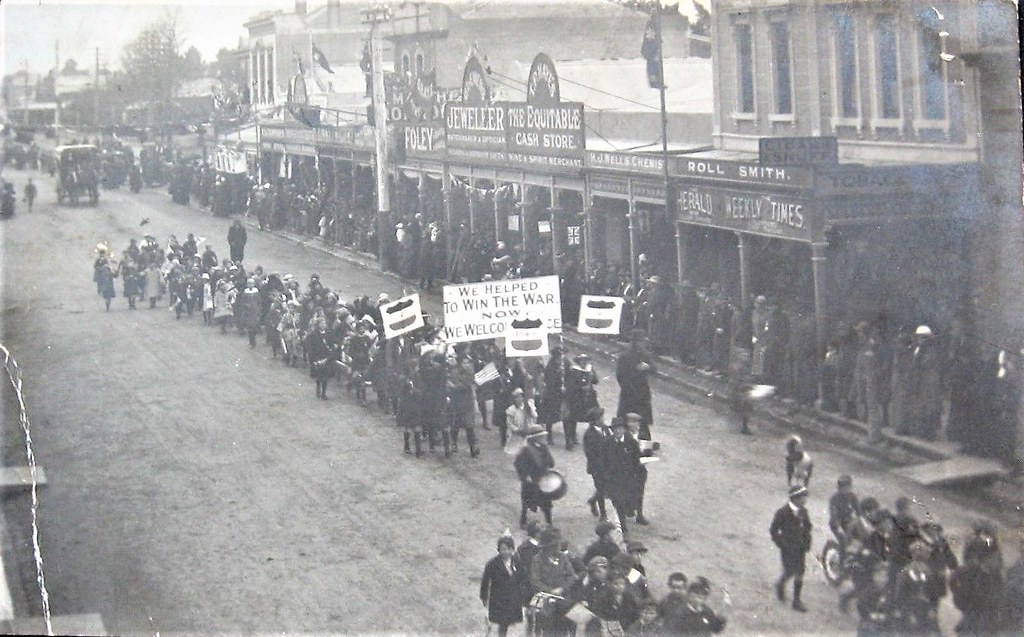 |
| Peace Parade after WW1 in Kyneton, Victoria. Kaye |
 |
| Weekly Times (Melbourne, Vic. : 1869 - 1954), Saturday 22 June 1940 |
1920s
 |
| Piper Street, Kyneton, Vic. c1920, SLVIC |
 |
| Back to Kyneton celebrations, VIC, Weekly Times (Melbourne, Vic. : 1869 - 1954), Saturday 31 January 1920 |
 |
| Kyneton Hospital, VIC, Weekly Times (Melbourne, Vic. : 1869 - 1954), Saturday 27 January 1923 |
 |
| Kyneton Ford, VIC, Weekly Times (Melbourne, Vic. : 1869 - 1954), Saturday 27 January 1923 |
 |
| Haystacks on Mrs Croile's farm, Kyneton, VIC, Weekly Times (Melbourne, Vic. : 1869 - 1954), Saturday 27 January 1923 |
 |
| "VICTORIA'S COUNTRY TOWNS" Weekly Times (Melbourne, Vic. : 1869 - 1954) 17 March 1928 |
1930s
 |
| KYNETON (Winner). -Left to right (back row)— F. Bourke. F. Douglas. W. Telford. P. Barry. H. Arkinstall. E. McMeakin. J. Shearman. "'jones Troor'lh-VA E. Kenny. H. Dunbar (vice-captain). L. Westcott (captain). H. Beare. T. Reher. B. Cameron (19th man). (Frontl-R. Wolfe. T. Hayes. T. Buckley L. Jones.Weekly Times (Melbourne, Vic. : 1869 - 1954), Saturday 25 June 1932 |
 |
| MINERAL SPRINGS POPULAR (1938, December 30). The Argus (Melbourne, Vic. : 1848 - 1957) |
 |
| A man and woman with their car and caravan at Kyneton mineral springs, VIC, c1935. Museums VIC |
 |
| Lincoln Mills (Australia) Limited, Kyneton, Argus (Melbourne, Vic. : 1848 - 1957), Saturday 3 June 1939 |
The Kyneton District Mounted Rifle Corps merged with two other units to become the famous Light Horse Brigade that charged Bersheeba in World War 1.
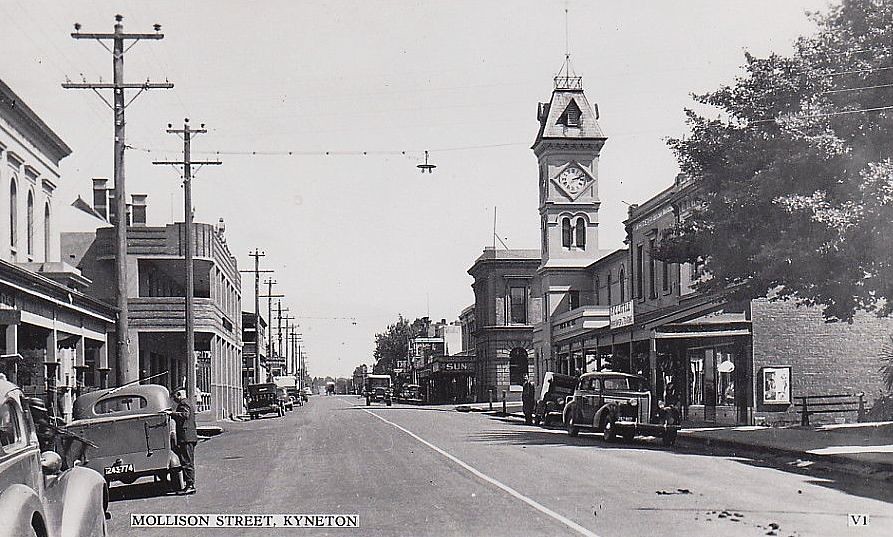 |
| Mollison Street, Kyneton, Victoria - circa 1940s. Kaye |
 |
| Newmarket Hotel, Kyneton, VIC, c1943, State Library of Victoria |
WWII
 |
Lieutenant Colonel Lewis John Loughran of Kyneton VIC, and his bride formerly Captain Eliza
beth A. Trumpp, of Brooklyn, an officer in the U.S. Women's Auxiliary Corps, after their marriage Newcastle Sun (NSW : 1918 - 1954), Tuesday 14 August 1945 |
1950s
 |
| CWA Kyneton, VIC, Weekly Times (Melbourne, Vic. : 1869 - 1954), Wednesday 2 April 1952 |
 |
| Kyneton Hospital nursing staff, VIC, Weekly Times (Melbourne, Vic. : 1869 - 1954), Wednesday 7 May 1952 |
 |
| Kyneton Football Club Ball, VIC, Weekly Times (Melbourne, Vic. : 1869 - 1954), Wednesday 11 June 1952 |
 |
| Argus (Melbourne, Vic. : 1848 - 1957), Thursday 20 January 1955 |
1990s
Kyneton was by-passed by a new freeway in 1995.
Kyneton is just 18 miles from
Daylesford.
Around Kyneton
 |
| Built in 1862 by Frederick Castilla, the Former Willis Flour Mill in Piper Street, Kyneton, VIC |
 |
| Mollison St, originally erected for the Bank of Victoria in 1875-76, Kyneton VIC |
 |
| Art Nouveau style Bank of New South Wales built in 1904 in Mollison Street, Kyneton VIC |
 |
| The Albion Hotel Formerly the Club Hotel built in 1861, Kyneton VIC |
 |
| Kyneton Mechanics Institute, circa 1858, Kyneton VIC |
 |
| The Kyneton Post Office was built in 1870-71, Kyneton VIC |
 |
| Kyneton Town Hall built in two stages in 1878-9 and 1929, Kyneton VIC |
 |
| The former Kyneton and District Butter and Cheese Factory (1860s), Kyneton VIC |
 |
| Our Lady of the Rosary Roman Catholic school, Kyneton (1830s), Kyneton VIC |
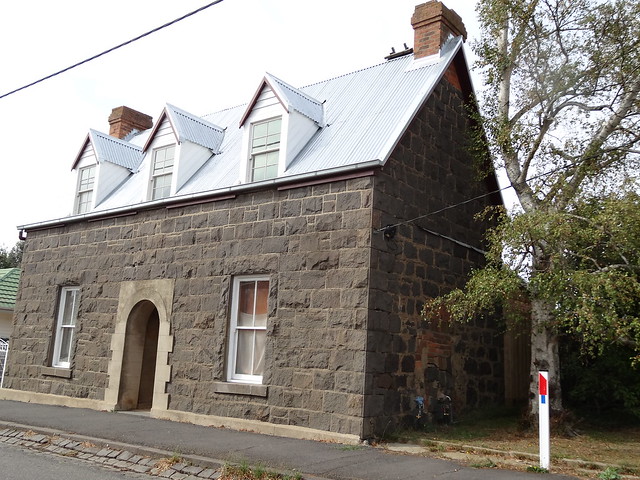 |
The Attic House, Kyneton, built 1858, Kyneton VIC
|
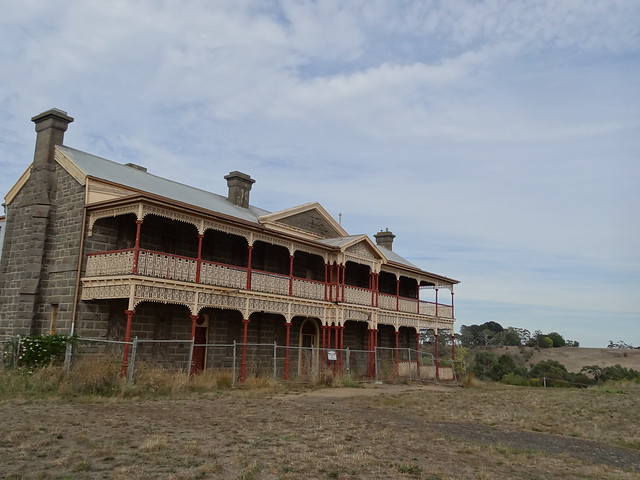 |
The old bluestone hospital, Kyneton, built in Georgian style bewteen 1854 and 1856, Kyneton VIC
|
 |
| Looking along Piper Street, Kyneton , Kyneton VIC |
 |
| Kyneton Museum, was built in 1856 as a Bank of New South Wales, Kyneton VIC |
 |
| Kyneton Theatre Company's home is the historic Bluestone Theatre, circa 1859, Kyneton VIC |
 |
| Carn Brae 1856, bluestone cottage, circa 1856, Kyneton VIC |
 |
| The blue stone manse was built in 1860, Kyneton VIC |
 |
| "Mt Pleasant", Carlsruhe Station Road, circa 1876, Kyneton VIC |
 |
| The Old Rectory, 1850, Kyneton VIC |
 |
| The Royal George Hotel (then the "Gold Diggers Arms") was built in 1852, Kyneton VIC |
 |
| Stone building, Kyneton VIC |
.jpg) |
| Kyneton Secondary College, circa 1912, Kyneton VIC |
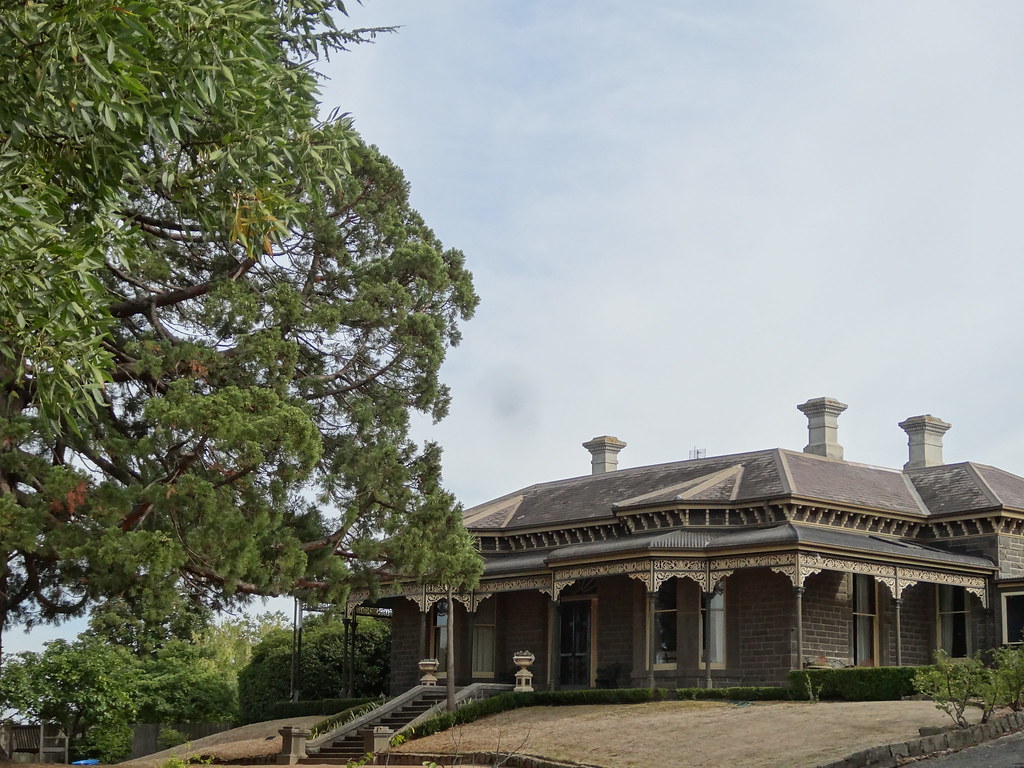 |
| Catherineville. A grand bluestone house built in 1872 for the first Shire of Kyneton president a local storekeeper called Mckenna. Relatives lived here until 1967. Veranda added in 1880s. Denisbin |
 |
| 1850s settler’s hut on Bunjil Farm, Kyneton, Kyneton VIC |
 |
| Historic Piper Street, Kyneton, VIC |
 |
| Aboriginal scar trees, Kyneton, VIC |
 |
| The Diggers Rest Hotel, at 1434-1466 Calder Highway, Kyneton, VIC (Established 1852) |
 |
| The exterior of the Catholic Church built in bluestone in 1857 as St Marys. Now known as Our Lady of the Rosary. denisbin |
 |
| St Mary's Parish Hall, Kyneton, VIC, Alpha |
 |
| Shamrock Hotel, Kyneton, VIC, Alpha |
 |
| Kyneton Courthouse, VIC, The Kyneton Courthouse tried Ned Kelly in 1870 for robbery under arms. The first courthouse was built here in 1848. This basalt court was built in 1857 |
 |
| Former Degraves Mill, Kyneton, VIC (688 Cobb and Co Road) |
 |
| 1850s windmill, Kyneton-Metcalfe Road, Kyneton, VIC |
Things To Do and Places To Go
Kyneton Mineral Springs Reserve
Novels Set in Victoria
The Call, a historical novel by Australian writer Martin Flanagan.
True History of the Kelly Gang, a novel by Australian writer Peter Carey.
The
Silver Brumby series is a collection of fiction children's books by Australian author Elyne Mitchell.


















































.jpg)
























